Apollo 15: Lunar Science to the Fore
The crew were (from left in photo) Commander Dave Scott, Command Module Pilot Al Worden, and Lunar Module Pilot Jim Irwin. Scott was making his third spaceflight, having flown alongside Neil Armstrong on Gemini 8 and as Command Module Pilot of Apollo 9. Both Irwin and Worden were making their first trip into space. 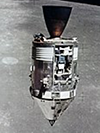
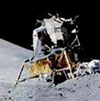
They named the Command Service (left) Module Endeavour, after one of the command ships of the famous English explorer James Cook, and the Lunar Module (right) Falcon, after the mascot of the U.S. Air Force Academy. The crew took with them a pair of falcon feathers and a piece of wood from Cook's ship. Among the other improvements were redesigned space suits and backpacks. Those worn by Scott and Irwin had the addition of a liquid cooling garment. The Apollo 15 mission was the first to have a heavy focus on science. NASA had brought in Caltech geologist Lee Silver to meet with the crews of the previous two Apollo missions, but it was Scott, the Apollo 15 commander, who pushed his crew to achieve as much as possible in the scientific realm. As a result, Silver led the crew on geology field trips during their terrestrial training, visiting sites in Arizona and New Mexico. As well, Worden, who would stay in the Command Module and orbit the Moon, studied intensely with another geologist, Farouk El-Baz, studying maps and photos of the lunar craters that he would see while in lunar orbit, so he could contribute to the surface missions. 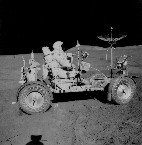
One of the big highlights of this mission was the debut of the Lunar Roving Vehicle. The 460-pound rolling craft could be folded into a space 5 feet by 20 inches and could carry a total of 1500 pounds, including the two astronauts. Each wheel had its own 200-watt electric motor. The craft could top a speed of 8 miles per hour. Blastoff was on the morning of July 26, 1971. The crew overcame a few technical difficulties along the way, including a leak in the water system that they plugged, and entered lunar orbit three days later. Scott and Irwin climbed into the Lunar Module and landed on the lunar surface on July 30, near Hadley Rille. Because of the dust that the landing craft was kicking up, the landing itself was a bit bumpy, to which Irwin yelled "Bam!" after they touched down. In order to get a view as high as possible, Scott climbed into the top hatch for a survey of the landscape. It was the only standup extravehicular activity (EVA) of any lunar landing mission. He and Irwin then slept for a time before strapping on their spacesuits and stepping onto the lunar surface. They deployed the Rover, which contained a remote TV camera, and then settled in for a drive on the Moon. As had previous Apollo crews, Scott and Irwin collected a number of samples of lunar dust and rocks, the utility of the Rover giving them the ability to range
relatively far and wide from their landing craft. Back at the Lunar Module, Scott employed a U.S. Postal Service kit to cancel a first day cover of two stamps being issued on that day, August 2. Then, he performed one of the Apollo program's most important experiments: Just before they left orbit, the crew released a small satellite that had the mission of studying the plasma and particle environments of the Moon and mapping its gravity field. The satellite orbited the Moon did its job until January 1973, when software failures shut it down. Scott and Irwin left behind a TV camera, which captured the ascent of the Lunar Module. They also left behind a plaque with the names of astronauts and cosmonauts who had died. Back in the Command Module, Worden was busy taking photos (including with a panoramic camera based on technology used in spy satellites) and performing experiments of his own. Among his equipment were an X-ray spectrometer, a gamma ray spectrometer, and an alpha particle spectrometer. (The data that Worden gathered would later help inform the landing site for Apollo 17.)  Together again, the crew left lunar orbit on August 4. The next day, Worden got his chance to experience space, performing the first deep space EVA (right). The return to Earth was relatively uneventful (the failure of one of the three splashdown parachutes being the only real issue), and the crew was back on August 7. The crew were involved in a controversy after they landed. All three had agreed to carry postal covers to the Moon and, after returning them to Earth, hand them over to a West German stamp dealer, who planned to sell them. The dealer paid each astronaut for doing this, and the crew had planned to use the money as a nest egg for their children. However, they did not have permission from NASA to do so. The space agency had sanctioned the first-day-cover exercise that Scott had undertaken, with full support of the U.S. Postal Service. But this was something different. When the crew's actions became public knowledge, they received official reprimands from NASA and were removed as the backup crew for Apollo 17. None of them flew in space again. 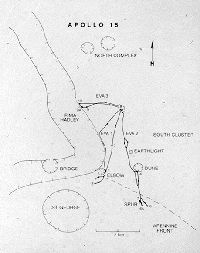
The Apollo 15 mission achieved all of its primary scientific objectives and brought home a large amount of knowledge and lunar materials for NASA scientists to study. Scott and Irwin drove a total of 17.5 miles in the Rover and collected more than 170 pounds of lunar samples, including a crust sample from 10 feet beneath the surface. They spent 18.5 hours on the lunar surface, including one 7.5-hour EVA, the longest expedition yet. They deployed 10 experiments. The photographs and scans taken by all three astronauts proved invaluable to scientists on the ground. What the crew recorded and shared certainly informed the next two Apollo missions. |
|
Social Studies for Kids
copyright 2002–2025
David White



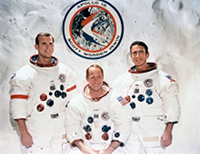 Apollo 15 was the fifth manned mission to the Moon and the fourth to include Moonwalks. A very scientifically focused mission, Apollo 15 featured the debut of a four-wheeled vehicle and the performance of an experiment to prove one of science's most famous theories.
Apollo 15 was the fifth manned mission to the Moon and the fourth to include Moonwalks. A very scientifically focused mission, Apollo 15 featured the debut of a four-wheeled vehicle and the performance of an experiment to prove one of science's most famous theories. Among the rocks that they brought back was the so-called Genesis Rock, thought to have been part of the lunar crust from earliest times.
Among the rocks that they brought back was the so-called Genesis Rock, thought to have been part of the lunar crust from earliest times.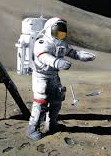 proving the theory of noted Italian scientist Galileo Galilei that objects in the same gravity field, even if they have different weights, fall at the same rate in the absence of aerodynamic drag. Galileo had attempted to prove his experiment by dropping various objects from the top of the Leaning Tower of Pisa and other places, but the air resistance of the Earth had always gotten in the way. Scott held a hammer in one hand and a feather in the other hand and dropped them at the same time. With the television cameras rolling, the hammer and the feather
proving the theory of noted Italian scientist Galileo Galilei that objects in the same gravity field, even if they have different weights, fall at the same rate in the absence of aerodynamic drag. Galileo had attempted to prove his experiment by dropping various objects from the top of the Leaning Tower of Pisa and other places, but the air resistance of the Earth had always gotten in the way. Scott held a hammer in one hand and a feather in the other hand and dropped them at the same time. With the television cameras rolling, the hammer and the feather 
